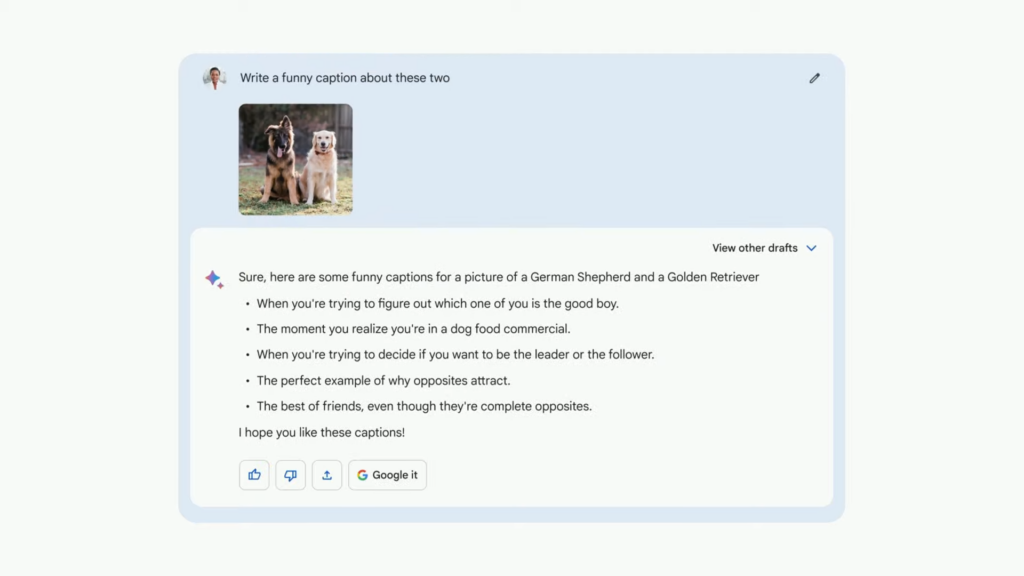Imagine the sunny streets of California(mountain view) buzzing with anticipation as the date of May 10, 2023, approached. The air was filled with an electric energy, for it was the day when Google, the tech giant, would unveil its much-anticipated annual Google Keynote event. People from all walks of life, from tech enthusiasts to curious onlookers, eagerly gathered in anticipation of what was to come. This year’s event promised to be a spectacle like no other, with promises of cutting-edge technology showcases and insightful device reviews that would leave attendees in awe.
Google’s Game-Changing Language Model Shaping the Future
Notably, Google has long been known as the leading AI company, even before OpenAI gained prominence. However, Google had been keeping its AI developments behind the scenes, safeguarding its brand name. It was only when OpenAI introduced their LLM (Large Language Model) ChatGPT that Google decided to step forward. And it was a wise move. ChatGPT has enabled numerous big companies to thrive and has given birth to new ventures. Additionally, we now even have an open-source chatbot called Open Assistant, not forgetting about Hugging Face Chat.
Related: Open Assistant: The Game-Changing Alternative to Chat GPT for Language Modeling
All of this progress is thanks to the rapid advancements in AI over the years. So, for a moment, let’s set aside the distractions of the cool AI stuff happening and quickly recap what took place at the Google IO event in 2023.
when openAi introduced ChatGPT, which gained immense popularity worldwide. and everyone thought AI and LLM were the future, Google struck back with their language model called BARD, which surpassed ChatGPT in terms of parameters (a staggering 1000:1 difference). However, within a week, people started to realize the potential complexities and dark side of AI. This raised questions about why Google would take such risks. But that was just the tip of the iceberg.
Since 2022, during the Google Keynote event, Google had already hinted at introducing AI to their search engine. It’s worth noting that a significant portion (90%) of Google’s revenue comes from its search feature. What does this tell us? Well, it’s a clear indication that AI, Artificial Intelligence, is not only the future but also the new normal.
Bard is expanding to over 180 countries and territories
 Bard, Google’s groundbreaking language model, has been making waves with its recent updates and features. One of the most exciting developments is Bard’s expansion to over 180 countries and territories, making it accessible to a wider audience. Previously, only trusted testers had the privilege of using Bard, but now, anyone can dive in and explore its capabilities.
Bard, Google’s groundbreaking language model, has been making waves with its recent updates and features. One of the most exciting developments is Bard’s expansion to over 180 countries and territories, making it accessible to a wider audience. Previously, only trusted testers had the privilege of using Bard, but now, anyone can dive in and explore its capabilities.
Bard now has app integration to maximize its utility and collaborative potential
With this expansion, Bard brings a host of new features to the table. App integration is a game-changer, particularly for developers. You can now ask Bard for code suggestions, completions, or even assistance with understanding complex code. It’s like having a coding companion by your side, ready to provide detailed explanations and insights.
Bard has image capabilities, coding features, and export features
Another significant advancement is Bard’s image capabilities. As a multimodal language model, Bard can now understand images and even generate new AI-generated images. This collaboration with Adobe brings forth the power of Adobe Firefly, enhancing Bard’s creative potential. It’s a fusion of text and visual elements that unlocks a whole new level of expression.
 But that’s not all. Bard has also been fine-tuned with coding abilities, expanding its understanding to over 20 programming languages. It can generate code snippets and provide citations to relevant documentation or blog posts, ensuring you have access to reliable resources for further exploration.
But that’s not all. Bard has also been fine-tuned with coding abilities, expanding its understanding to over 20 programming languages. It can generate code snippets and provide citations to relevant documentation or blog posts, ensuring you have access to reliable resources for further exploration.
Bard can now connect with Google apps and services like Docs, Drive, Gmail, Maps, and others
Furthermore, Bard seamlessly connects with various Google apps and services, including Docs, Drive, Gmail, Maps, and more. Imagine the possibilities when Bard collaborates with these tools, allowing you to search, gather information, and create seamlessly across different platforms.
Bard has better summarization capabilities
Summarization capabilities have also been enhanced, giving Bard the ability to distill large amounts of information into concise and meaningful summaries. This can be a valuable tool for researchers, students, or anyone seeking quick and accurate insights.
Bard now supports dark mode and Workspace accounts
To improve user experience, Bard now supports dark mode, offering a visually pleasing and customizable interface. Whether you have specific preferences or need to reduce eye strain, the dark theme enhances usability.

Google Lens is coming to Bard
Excitingly, Google Lens is coming to Bard, allowing users to upload photos and ask prompts regarding the images. This integration brings image understanding to a new level, enabling you to interact with visuals and gain deeper insights.
Overall, the event focused heavily on AI and showcased how Google is using generative AI to improve its products and make AI more helpful for everyone
